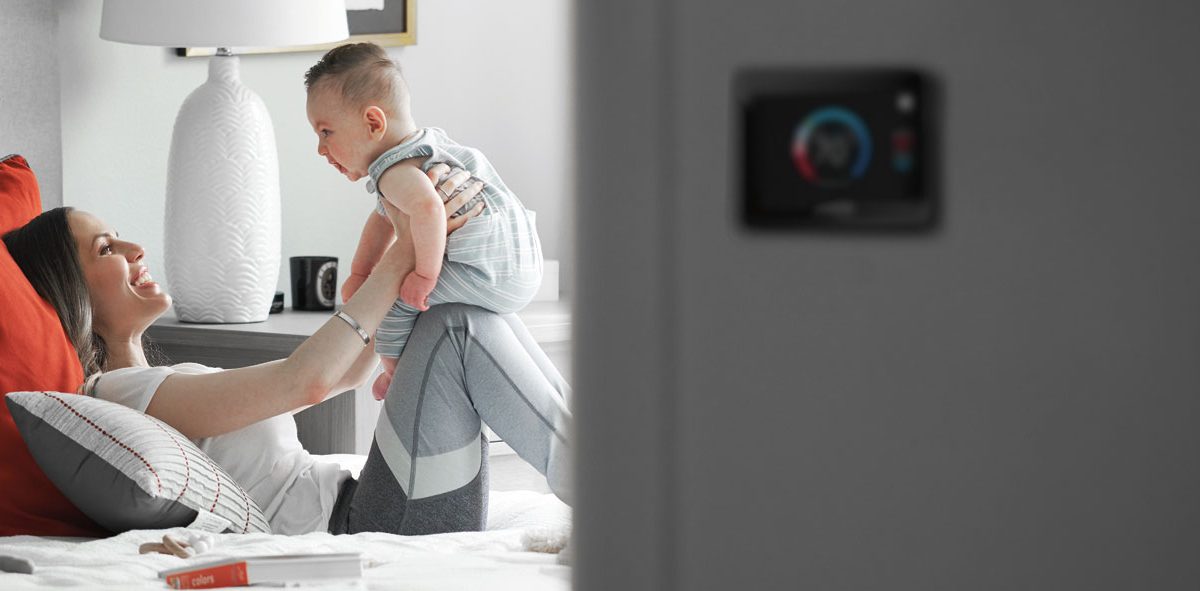What Temperature Should You Set Your Thermostat in Winter?

Types of Thermostats in Heating and Cooling Systems
February 2, 2025
Elite Series – EL297V
February 9, 2025What Temperature Should You Set Your Thermostat in Winter?
Winter in Canada comes with its share of challenges, from freezing temperatures to rising heating costs. Balancing warmth and energy efficiency is essential, but many homeowners wonder: What is the best thermostat setting in winter? By optimizing your thermostat temperature this winter, you can create a comfortable home while saving on energy bills. Here’s everything you need to know about energy-saving thermostat settings and tips to maximize your home’s efficiency.
Best Thermostat Settings for Canada’s Winter
When setting your thermostat during the winter months, the goal is to find a balance between comfort and energy efficiency. Here are the key recommendations:
Daytime Comfort (When You’re at Home)
The ideal winter home temperature for most households is between 20°C and 22°C (68°F to 72°F) during the day. This range provides comfort without overloading your heating system. By avoiding excessive heating, you can lower your energy bills and reduce environmental impact.
Nighttime Savings (While You Sleep)
Adjusting your thermostat at night can lead to significant savings. Experts recommend setting the thermostat to 17°C to 19°C (62°F to 66°F) while you sleep. Research suggests that cooler temperatures improve sleep quality, making this a win-win for both your health and your wallet.
When You’re Away from Home
For times when your home is unoccupied, such as during work hours, set the thermostat to around 17°C to 19°C. This temperature prevents freezing pipes while minimizing energy usage. For households with seniors or young children, ensure the thermostat doesn’t drop below safe levels to avoid discomfort or health risks.
Energy-Saving Thermostat Settings for Canada
Canadian winters are harsh, with temperatures often plummeting below freezing. Choosing energy-efficient heating tips tailored to your climate can save you hundreds of dollars annually.
Programmable and Smart Thermostats for Winter Savings
Switching to a programmable or smart thermostat is one of the easiest ways to save on heating costs in Canada. These devices allow you to schedule temperature adjustments automatically. For example:
- Lower the temperature when you’re at work.
- Set the thermostat to warm your home before you wake up or return in the evening.
- Use geofencing features on smart thermostats to adjust the temperature when you leave or return home.
A smart thermostat also provides detailed insights into your energy usage, helping you make informed adjustments to reduce heating costs in Canadian winters.
Tips for Reducing Heating Costs Without Sacrificing Comfort
Optimizing your thermostat settings is only part of the equation. Here are additional ways to lower your heating costs and maintain a cozy home:
1. Insulate Your Home Properly
Proper insulation is key to maintaining an ideal winter home temperature. Insulate your attic, walls, and basement to prevent heat loss. This reduces the strain on your heating system and lowers your energy bills.
2. Seal Drafts and Cracks
Cold air can enter through gaps in doors, windows, and walls. Sealing drafts with caulking or weatherstripping can significantly improve energy efficiency. Consider adding thermal curtains for extra insulation.
3. Use Rugs and Heavy Curtains
Rugs can insulate cold floors, while heavy curtains help retain warmth. These simple changes enhance comfort, allowing you to set your thermostat temperature lower without feeling chilly.
4. Schedule Furnace Maintenance
An efficient furnace consumes less energy to heat your home. Schedule annual tune-ups to ensure your system operates efficiently throughout the winter.
Why a Smart Thermostat is Worth the Investment
Smart thermostats for winter savings are becoming increasingly popular in Canada. Here’s why they’re a worthwhile investment:
- Learning Your Schedule: Smart thermostats can learn your routine and adjust temperatures automatically, saving energy without compromising comfort.
- Remote Access: Control your thermostat from anywhere using a smartphone app.
- Energy Reports: Many models provide detailed insights into your energy usage, helping you make smarter decisions.
- Integration with Other Smart Devices: Combine your smart thermostat with home assistants like Alexa or Google Home for seamless control.
These features make it easy to implement energy-saving thermostat settings and reduce heating costs in Canadian winters.
What Temperature Should I Set My Thermostat in Winter in Canada?
There’s no universal answer to this question, as the ideal thermostat setting depends on your home’s insulation, your schedule, and your family’s preferences. However, following these guidelines can help:
- Adjust temperatures based on the time of day (daytime vs. nighttime).
- Lower the thermostat when no one is home.
- Consider the needs of seniors, children, or pets in your household.
Final Thoughts: Optimize Comfort and Cut Costs
Managing your thermostat temperature this winter doesn’t have to be complicated. By setting your thermostat to energy-saving temperatures, investing in a smart thermostat, and implementing energy-efficient heating tips, you can enjoy a cozy home while saving money.
Looking for expert advice on programmable or smart thermostat installations? Contact Alliance Energy Source for professional guidance and services. Call us today or schedule an appointment online to optimize your winter home temperature!

